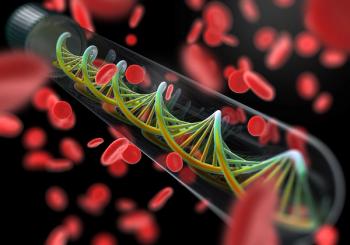
- ONCOLOGY Vol 11 No 10
- Volume 11
- Issue 10
Cisplatin Alone vs Cisplatin Plus Vinorelbine in Stage IV NSCLC
Cisplatin (Platinol) has played a major role in the treatment of non-small-cell lung cancer (NSCLC). As a single agent, cisplatin has produced a response rate of approximately 21% in a large number of trials.
ABSTRACT: Cisplatin (Platinol) has played a major role in the treatment of non-small-cell lung cancer (NSCLC). As a single agent, cisplatin has produced a response rate of approximately 21% in a large number of trials. Because studies of cisplatin dose intensity have failed to confirm a dose-response relationship, the focus has shifted toward the possibility of improving efficacy through the use of this drug in combination regimens. The combination of cisplatin with other agents, including etoposide (VePesid) and vindesine (Eldisine), has resulted in improved response rates that do not necessarily translate into improved survival. Vinorelbine (Navelbine) is a unique semisynthetic Vinca alkaloid that has activity as a single agent in the treatment of NSCLC. Furthermore, a randomized trial revealed a survival advantage with cisplatin plus vinorelbine when compared with single-agent vinorelbine or cisplatin plus vindesine. In light of these findings, the Southwest Oncology Group (SWOG) undertook a trial comparing cisplatin alone vs cisplatin plus vinorelbine in patients with stage IV or IIIB NSCLC. The final results of this recently completed trial will be reported in the near future. Because of the encouraging results of an interim analysis, SWOG has initiated a new trial comparing cisplatin plus vinorelbine vs paclitaxel (Taxol) plus carboplatin (Paraplatin) in NSCLC. [ONCOLOGY 11(Suppl 12):28-30, 1997]
Cisplatin (Platinol) has had a prominent place in the treatment of non-small-cell lung cancer (NSCLC). In 17 studies involving 568 patients, a response rate of approximately 21% was achieved when cisplatin was administered as a single agent in doses ranging from 75 to 200 mg/m2.[1] Responses tended to be better in previously untreated patients and in those who received doses greater than 100 mg/m2. The response rate was approximately 14% at doses below this level and ranged from 21% to 24% at higher doses.
In an effort to improve the rate of response, investigators have examined the use of cisplatin at higher doses, as well as in combination with other agents.
In 1981, Gralla and co-workers evaluated cisplatin doses of 60 and 120 mg/m2, each in combination with vindesine (Eldisine), in 80 patients with primarily metastatic non-small-cell lung cancer.[2] Although response rates were fairly equivalent in the two arms (46% and 40%, respectively), the higher dose showed a promising survival advantage. Among responders, the median survival was 21.7 months with 120 mg/m2 of cisplatin, as opposed to 10 months with 60 mg/m2. Klastersky et al assessed the same two cisplatin doses in combination with etoposide (VePesid).[3] The 60- and 120-mg/m2 doses were similar with regard to response rates (25% and 29%, respectively), median survival (33 and 28 weeks, respectively), and 1-year survival rates (approximately 30% in both arms). The investigators suggested that the contrast between these findings and the results of the study by Gralla et al might be explained by differences between etoposide and vindesine.
The impact of cisplatin dose intensity was subsequently evaluated in work conducted within the Southwest Oncology Group (SWOG).[4] More than 300 patients received 50 mg/m2 of cisplatin on days 1 and 8, 100 mg/m2 on days 1 and 8, or 100 mg/m2 plus mitomycin (Mutamycin). The rate of response was comparable with 50 and 100 mg/m2 of cisplatin (12% and 14%, respectively), but was considerably higher (27%) when mitomycin was added to the higher dose. Nonetheless, median survival did not differ significantly among the three groups (6.9, 5.3, and 7.2 months, respectively), and 1-year survival rates were identical (20%).
In the absence of evidence showing a dose-response relationship for cisplatin, interest turned toward the possibility of enhancing efficacy through the addition of other agents. The feasibility of this approach was suggested by preclinical data demonstrating that the Vinca alkaloids and etoposide are synergistic with cisplatin.[5]
Of the many studies in this area, two are of particular interest. First, Klastersky et al evaluated the use of cisplatin (120 mg/m2) alone or in combination with etoposide.[6] Although the response rates (19% vs 26%, respectively) suggested a potential advantage of combination treatment, this finding did not translate into improved survival. The median survival was 26 weeks with cisplatin alone vs 22 weeks with cisplatin plus etoposide. The 1-year survival rates were approximately 25% and 23%, respectively.
In another study, Kawahara and colleagues observed similar trends when cisplatin (80 mg/m2) was administered alone or in combination with vindesine.[7] Again, a lower rate of response was seen with cisplatin alone than with the combination (12% vs 29%). However, survival rates were similar in the two arms (median, 39 vs 45 weeks; 1-year rate, 42% vs 41%).
Vinorelbine (Navelbine) is a unique semisynthetic Vinca alkaloid that has activity as a single agent in non-small-cell lung cancer (Table 1).[8-10] Furthermore, a randomized trial by Le Chevalier et al found that the combination of cisplatin plus vinorelbine produced better response rates than single-agent vinorelbine or cisplatin plus vindesine (Table 2).[11] This improved response translated into improved survival. These observations provided the impetus for a SWOG study comparing the effect of cisplatin alone vs cisplatin plus vinorelbine in non-small-cell lung cancer (SWOG 9308).[12]
The objective of the SWOG 9308 trial was to compare the efficacy of cisplatin alone vs cisplatin plus vinorelbine with respect to response rate, survival, and time to progression. Toxicities were also evaluated.
To be eligible for the trial, patients were required to have stage IV non-small-cell lung cancer or stage IIIB disease with pleural effusion or multiple ipsilateral lung nodules. In addition, patients had to have a SWOG performance status of 0 to 1; no prior chemotherapy; adequate hematologic, renal, and hepatic function; and no significant unstable medical conditions. Patients with brain metastases were excluded, and radiation therapy was not permitted during the study.
The patients were stratified according to several criteria: lactate dehydrogenase status (normal vs abnormal), disease status (measurable vs evaluable), prior surgical resection or radiation therapy, histology (squamous cell, large cell, adenocarcinoma, or unspecified), and disease stage (IIIB or IV).
The patients were randomized to receive cisplatin (100 mg/m2 every 4 weeks) or the same cisplatin regimen in combination with vinorelbine (25 mg/m2/week). The protocol also allowed for modification of the cisplatin dose in cases of grade 4 neutropenia, neutropenic fever or sepsis, renal insufficiency, or neurotoxicity. The vinorelbine dose could be modified in response to grade 3 or 4 neutropenia, neutropenic fever or sepsis, hyperbilirubinemia, or neurotoxicity. Granulocyte colony-stimulating factor (G-CSF, filgrastim [Neupogen]) was allowed after the first course of chemotherapy if grade 3 or 4 neutropenia or an infection related to neutropenia occurred.
This study was recently completed, and the results have been reported in abstract form.[12] The complete results will be published in the near future. In view of the encouraging results of an interim analysis, the SWOG investigators have accepted the combination of cisplatin and vinorelbine as their new standard therapy for advanced non-small-cell lung cancer. They have also initiated a new phase III, randomized trial comparing cisplatin plus vinorelbine vs paclitaxel (Taxol) plus carboplatin (Paraplatin) in patients with stage IV non-small-cell lung cancer.
The results of these trials promise to shed important new light on the relative merits of combination chemotherapy with vinorelbine in patients with advanced non-small-cell lung cancer.
References:
1. Bunn PA Jr: The expanding role of cisplatin in the treatment of non-small-cell lung cancer. Semin Oncol 16(4 suppl 6):10-21, 1989.
2. Gralla RJ, Caspar ES, Elsen DP, et al: Cisplatin and vindesine combination chemotherapy for advanced carcinoma of the lung: a randomized trial investigating two dosage schedules. Ann Intern Med 95:414-420, 1981.
3. Klastersky J, Sculier JP, Ravez P, et al: A randomized study comparing a high and a standard dose of cisplatin in combination with etoposide in the treatment of advanced non-small-cell lung carcinoma. J Clin Oncol 4:1780-1786, 1986.
4. Gandara DR, Crowley J, Livingston RB, et al: Evaluation of cisplatin intensity in metastatic non-small-cell lung cancer: A phase III study of the Southwest Oncology Group. J Clin Oncol 11:873-878, 1993.
5. Schabel EM, Trader MW, Laster WR, et al: Cis-dichlorodiammine-platinum (II): Combination chemotherapy and cross-resistance studies with tumors of mice. Cancer Treat Rep 63:1459-1473, 1979.
6. Klastersky JP, Schulier G, Bureau P, et al: Cisplatin versus cisplatin plus etoposide in the treatment of advanced non-small cell lung cancer. J Clin Oncol 7:1087,1092, 1989.
7. Kawahara M, Furuse K, Kodama N, et al: A randomized study of cisplatin versus cisplatin plus vindesine for non-small cell lung carcinoma. Cancer 68:714-719, 1991.
8. Depierre A, Lemarie E, Dubouis G, et al: A phase II study of Navelbine (vinorelbine) in the treatment of non-small-cell lung cancer. Am J Clin Oncol 14:115-119, 1991.
9. Furuse K, Kubota K, Kawahara M, et al: A phase II study of vinorelbine, a new derivative of Vinca alkaloid, for previously untreated advanced non-small cell lung cancer. Japan Vinorelbine Lung Cancer Study Group. Lung Cancer 11:385-391, 1994.
10. Crawford J, ORourke M, Schiller JH, et al: Randomized trial of vinorelbine compared with fluorouracil plus leucovorin in patients with stage IV non-small-cell lung cancer. J Clin Oncol 14:2774-2784, 1996.
11. Le Chevalier T, Brisgand D, Douillard J-Y, et al: Randomized study of vinorelbine and cisplatin versus vindesine and cisplatin versus vinorelbine alone in advanced non-small-cell lung cancer: Results of a European multicenter trial including 612 patients. J Clin Oncol 12:360-367, 1994.
12. Wozniak AJ, Crowley JJ, Balcerzak SP, et al: Randomized phase III trial of cisplatin vs cisplatin plus Navelbine in treatment of advanced non-small-cell lung cancer: Report of a Southwest Oncology Group study (SWOG 9308). Proc Am Soc Clin Oncol 15:374, 1996
Articles in this issue
about 28 years ago
Vinorelbine in Non-Small-Cell Lung Cancerabout 28 years ago
Paclitaxel and Vinorelbine in Non-Small-Cell Lung Cancerabout 28 years ago
Safety Data From North American Trials of Vinorelbineabout 28 years ago
Current Management of Unresectable Non-Small-Cell Lung Cancerabout 28 years ago
The Economics of Prostate Cancer ScreeningNewsletter
Stay up to date on recent advances in the multidisciplinary approach to cancer.
















































































